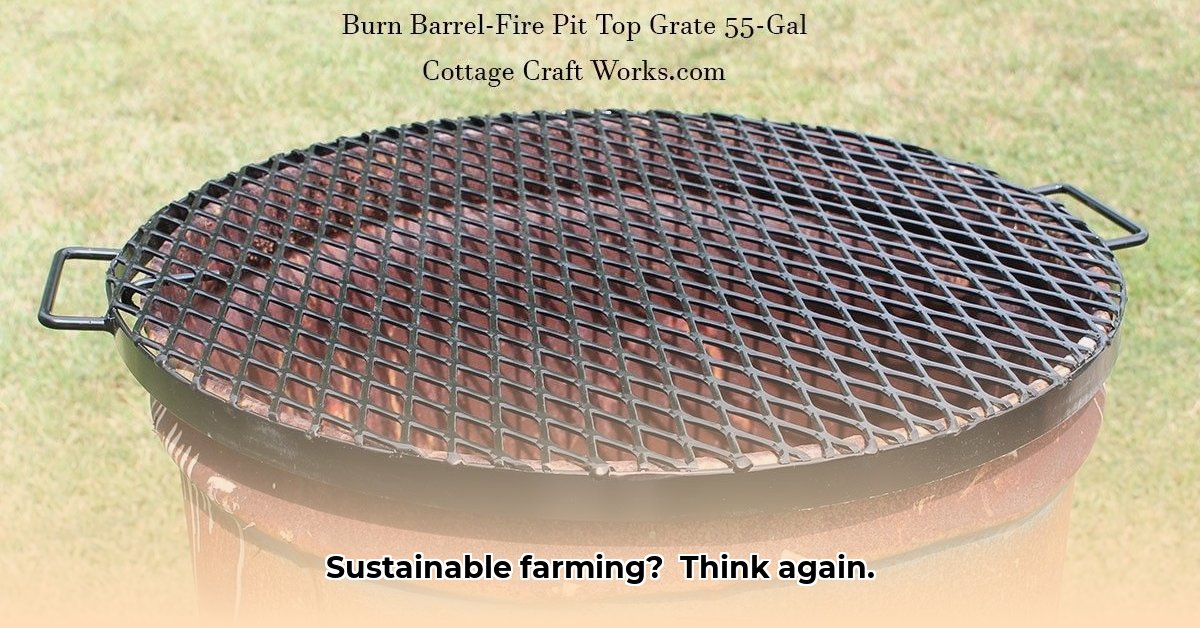
Sustainable Agricultural Waste Management: Beyond the Burn Barrel
Let's be honest: managing agricultural waste is a significant challenge for farmers. Burn barrels, readily available at Tractor Supply and other retailers, might seem like a quick solution, but are they truly sustainable? This guide explores the environmental and economic implications of burn barrels, highlighting cleaner, more profitable alternatives for sustainable farm waste management. For larger-scale fuel storage, explore options like farm fuel tanks.
Why Burn Barrels Aren't the Answer
While burn barrels offer a seemingly simple solution for waste disposal, significant drawbacks outweigh the perceived advantages. The quick reduction of waste comes at a substantial cost.
Disadvantages of Burn Barrels:
- Air Pollution: Burning organic matter releases harmful pollutants, contributing to smog and greenhouse gas emissions. This negatively impacts air quality and contributes to climate change. Dr. Emily Carter, Professor of Chemical and Biological Engineering at Princeton University, notes, "The impact of agricultural burning on air quality is substantial, often exceeding regulated emission limits."
- Soil Degradation: The process often results in the loss of valuable nutrients that could otherwise enrich the soil. This ultimately reduces soil fertility and long-term crop yields.
- Health Risks: Inhaling smoke from burning agricultural waste poses significant health risks, potentially leading to respiratory problems and other health complications.
- Legal Ramifications: Many jurisdictions have regulations and laws restricting open burning due to its environmental impact, leading to potential fines and penalties.
Sustainable Alternatives for Farm Waste Management
Fortunately, numerous environmentally friendly and economically viable alternatives exist. These methods not only reduce environmental impact but can also offer additional benefits like improved soil health and renewable energy generation.
1. Composting: Nature's Recycler
Composting transforms organic waste (plant matter, manure, food scraps) into nutrient-rich compost, a valuable soil amendment. This natural process significantly improves soil health, enhances water retention, and reduces the need for synthetic fertilizers. Moreover, composting is relatively inexpensive and can be implemented on various scales, from small backyard setups to large-scale operations.
2. Anaerobic Digestion: Waste to Energy and Fertilizer
Anaerobic digestion breaks down organic waste in the absence of oxygen, yielding biogas (a renewable energy source) and digestate (a nutrient-rich fertilizer). While the initial investment is higher than composting, the long-term benefits—reduced reliance on fossil fuels and improved soil fertility—make it a highly attractive option. "Anaerobic digestion offers a circular economy approach, converting waste into valuable resources," explains Dr. David Smith, Agricultural Engineer at the University of California, Davis.
3. In-Field Incorporation & Mulching
- In-field incorporation: Directly incorporating crop residues into the soil improves soil structure and organic matter content. This minimizes waste removal and enhances soil health.
- Mulching: Spreading organic waste as mulch around plants retains soil moisture, suppresses weeds, and provides organic nutrients as it decomposes. This method improves soil health while reducing the need for irrigation and weed control.
Transitioning to Sustainable Waste Management: A Practical Step-by-Step Guide
- Waste Assessment: Thoroughly analyze the types and quantities of waste generated on your farm. This detailed assessment informs the selection of appropriate management strategies.
- Method Selection: Choose a sustainable waste management approach best suited to your farm's size, resources, and waste profile (e.g., composting for smaller farms, anaerobic digestion for larger operations).
- Resource Acquisition: Investigate potential funding opportunities (grants, subsidies) available at the local, state, or federal level to support the implementation of sustainable practices.
- Phased Implementation: Start with a pilot program for your chosen method before committing to a full-scale implementation. This minimizes risk and allows for adjustments based on initial results.
- Monitoring & Adaptation: Continuously monitor your chosen approach, collecting data to assess its effectiveness and make necessary adjustments to optimize the process.
The Bottom Line: Investing in a Sustainable Future
While burn barrels offer a seemingly convenient solution to agricultural waste management, the long-term environmental and economic consequences far outweigh any short-term advantages. Sustainable alternatives offer a pathway towards a more environmentally responsible and profitable future for your farm. The question isn't just about managing waste; it's about creating a thriving, sustainable agricultural operation for years to come.